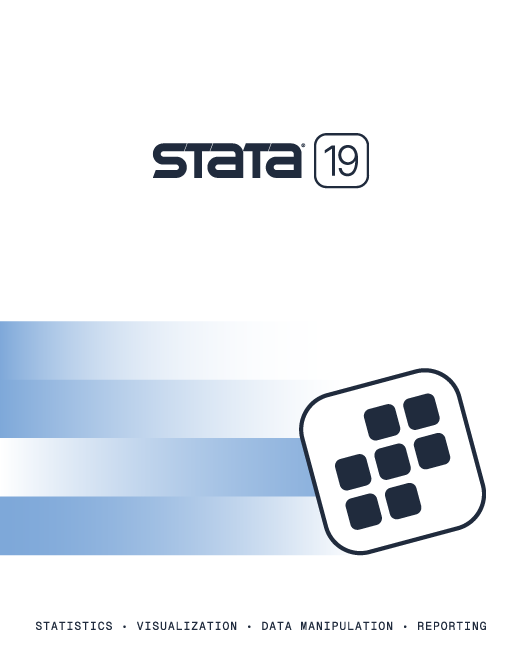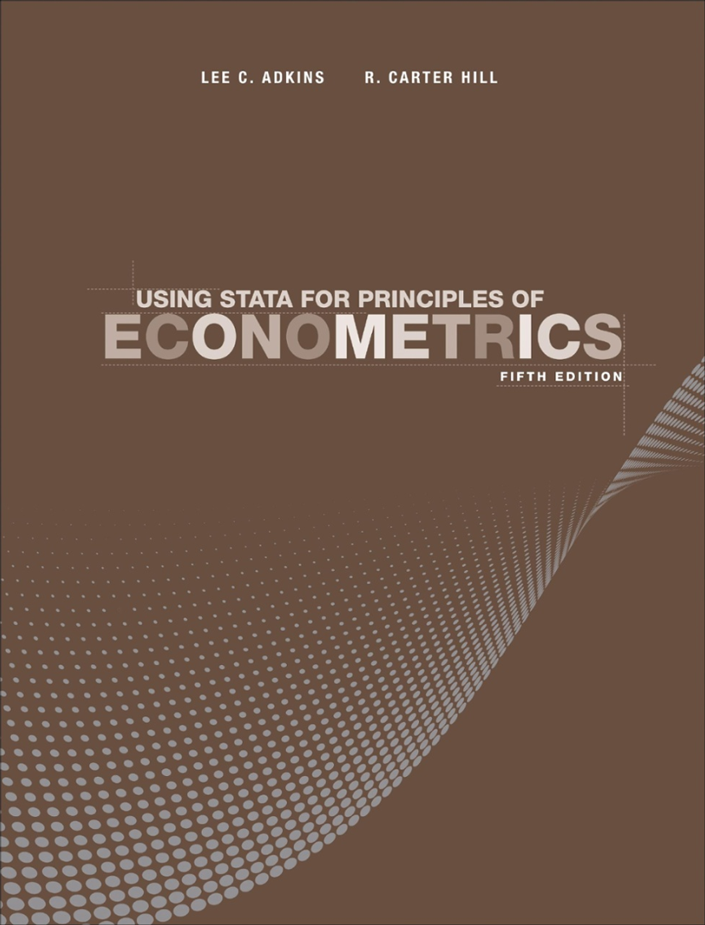
Using Stata for Principles of Econometrics, Fifth Edition |
||||||||||||||||||||||||||||||||
 Click to enlarge |

As an Amazon Associate, StataCorp earns a small referral credit from
qualifying purchases made from affiliate links on our site.
eBook not available for this title
eBook not available for this title |
|
||||||||||||||||||||||||||||||
Comment from the Stata technical groupComments from the fourth edition: Using Stata for Principles of Econometrics, Fourth Edition, by Lee C. Adkins and R. Carter Hill, is a companion to the introductory econometrics textbook Principles of Econometrics, Fourth Edition. Together, the two books provide a very good introduction to econometrics for undergraduate students and first-year graduate students. The main textbook takes a learn-by-doing approach to econometric analysis, and this companion book illustrates the "doing" part using Stata. Adkins and Hill briefly show how to use Stata's menu system and command line before delving into their many examples. Using Stata for Principles of Econometrics, Fourth Edition shows how to use Stata to reproduce the examples in the main textbook and how to interpret the output. The current edition has been updated to include features introduced in Stata 11, such as the margins command to compute elasticities. Together with Principles of Econometrics, Fourth Edition, the reader will not only learn econometrics but also gain the confidence needed to perform his or her own work using Stata. |
||||||||||||||||||||||||||||||||
Table of contentsView table of contents >> Chapter 2 Simple linear regression
Key Terms
2.1 The food expenditure data
2.1.1 Starting a new problem
2.2 Computing summary statistics 2.1.2 Starting a log file 2.1.3 Opening a Stata data file 2.1.4 Browsing and listing the data 2.3 Creating a scatter diagram
2.3.1 Enhancing the plot
2.4 Regression
2.4.1 Fitted values and residuals
2.5 Using Stata to obtain predicted values 2.4.2 Plotting the fitted regression line
2.5.1 Using saved coefficients
2.6 OLS estimator variances and covariance2.5.2 Using lincom 2.5.3 Using the margins command 2.5.4 Using incomplete observations 2.5.5 Computing an elasticity
2.6.1 Estimating the variance of the error term
2.7 Estimating nonlinear relationships2.6.2 Viewing the estimated variances and covariance 2.6.3 Saving the Stata data file
2.7.1 A quadratic model
2.8 Regression with indicator variables2.7.2 A log-linear model Appendix 2A Average marginal effects
2A.1 Elasticity in a linear relationship
Appendix 2B Simulation experiment 2A.2 Elasticity in a quadratic relationship 2A.3 Slope in a log-linear model
2B.1 Fixed x's
2B.2 Random x's Chapter 2 Do-file Chapter 3 Interval Estimation and Hypothesis Testing
Key Terms
3.1 Interval estimates
3.1.1 Critical values from the t-distribution
3.2 Hypothesis tests 3.1.2 Creating an interval estimate 3.1.3 Creating an interval estimate using lincom
3.2.1 Right-tail test of significance
3.3p-values 3.2.2 Right-tail test of an economic hypothesis 3.2.3 Left-tail test of an economic hypothesis 3.2.4 Two-tail test of an economic hypothesis 3.2.5 Two-tail test of significance
3.3.1 p-value of a right-tail test
Appendix 3A Graphical tools 3.3.2 p-value of a left-tail test 3.3.3 p-value for a two-tail test 3.3.4 p-values in Stata output 3.3.5 Testing and estimating linear combinations of parameters Appendix 3B Monte Carlo simulation
3B.1 Fixed x's
Chapter 3 Do-file 3B.2 Random x's Chapter 4 Prediction, Goodness-of-Fit and Modeling Issues
Key Terms
4.1 Least squares prediction
4.1.1 Editing the data
4.2 Measuring goodness-of-fit
4.1.2 Estimate the regression and obtain postestimation results 4.1.3 Creating the prediction interval 4.1.4 Using margins to create the prediction Interval
4.2.1 Correlations and R2
4.3 The effects of scaling and transforming the Data
4.3.1 Reporting the regression results
4.4 Analyzing the residuals 4.3.2 The linear-log functional form 4.3.3 Plotting the fitted linear-log model 4.3.4 Editing graphs
4.4.1 Residual plots
4.5 Polynomial models
4.4.2 The Jarque-Bera test 4.4.3 Chi-square distribution critical values 4.4.4 Chi-square distribution p-values 4.4.5 Identifying unusual observations
4.5.1 Estimating and checking the linear relationship
4.6 Estimating a log-linear wage equation
4.5.2 Estimating and checking a cubic equation 4.5.3 Estimating a log-linear yield growth model
4.6.1 The log-linear model
4.7 A log-log model 4.6.2 Calculating wage predictions 4.6.3 Constructing wage plots 4.6.4 Generalized R2 4.6.5 Prediction intervals in the log-linear model 4.6.6 Prediction intervals in the log-linear model using margins Chapter 4 Do-file Chapter 5 Multiple Linear Regression
Key Terms
5.1 The Hamburger Chain Model 5.2 Least squares prediction
5.2.1 Least squares procedure
5.3 Least Squares Precision 5.2.2 Least squares prediction 5.2.3 Rescaling the variables 5.2.4 Estimating the error variance 5.2.5 Measuring the goodness-of-fit 5.2.6 Frisch-Waugh-Lovell 5.4 Confidence intervals
5.4.1 Changing the confidence level
5.5 Hypothesis tests 5.4.2 Linear combination of parameters
5.5.1 Two-sided t-tests
5.6 Interaction Variables 5.5.2 One-sided t-tests 5.5.3 Testing a linear combination of parameters
5.6.1 Polynomial regressors
Appendix 5B.1 Nonlinear functions of a single parameter 5.6.2 Using factor variables for interactions 5.6.3 Interactions with other variables 5.6.4 Log-wages and quadratic interactions 5.6.5 Optimal level of advertising 5.6.7 Maximizing wages via experience Appendix 5B.2 Nonlinear functions of two parameters Appendix 5C.1 Least squares estimation with chi-square errors Appendix 5C.2 Monte Carlo simulation of the delta method Appendix 5D Bootstrapping Chapter 5 Do-file Chapter 6 Further Inference in the Multiple Regression Model
Key Terms
6.1 Testing joint hypotheses: The F-test
6.1.1 Testing the significance of the model
6.2 Stata programs 6.1.2 Relationship between t- and F-tests 6.1.3 More general F-tests 6.1.4 Large sample tests 6.1.5 Nonlinear hypothesis tests 6.3 Nonsample information 6.4 Model specification
6.4.1 Omitted variables
6.5 Poor data, collinearity, and insignificance 6.4.2 Irrelevant variables 6.4.3 Choosing the model 6.4.4 RESET test for function form 6.4.5 RESET program 6.4.6 Control variables 6.4.7 Prediction-forecast error variance 6.4.8 Prediction-model selection and RMSE
6.5.1 Variance inflation factors
Chapter 6 Do-file 6.5.2 Influential observations Chapter 7 Using Indicator Variables
Key Terms
Chapter 7 Do-file
7.1 Indicator variables
7.1.1 Creating indicator variables
7.2 Applying indicator variables 7.1.2 Estimating an indicator variable regression 7.1.3 Testing the significance of the indicator variables 7.1.4 Further calculations 7.1.5 Computing average marginal effects
7.2.1 Interactions between qualitative factors
7.3 The linear probability model 7.2.2 Adding regional indicators 7.2.3 Testing the equivalence of two regressions 7.2.4 Estimating separate regressions 7.2.5 Indicator variables in log-linear models 7.4 Treatment effects 7.5 Differences-in-Differences estimation Chapter 8 Heteroskedasticity
Key Terms
8.1 The nature of heteroskedasticity 8.2 Heteroskedastic-consistent standard errors 8.3 The generalized least squares estimator
8.3.1 Feasible GLS-a more general case
8.4 Detecting heteroskedasticity 8.3.2 Feasible GLS with a heteroskedastic partition
8.4.1 The Goldfeld-Quandt test using partitioned data
8.5 Heteroskedasticity in the linear probability model 8.4.2 The Goldfeld-Quandt test in the food expenditure model 8.4.3 Lagrange multiplier tests Appendix 8D Alternative robust sandwich estimators Appendix 8E Monte Carlo evidence Chapter 8 Do-file Chapter 9 Regression with Time-Series Data: Stationary Variables
Key Terms
9.1 Introduction
9.1.1 Defining time-series in Stata
9.2 Correlogram 9.1.2 Time-series plots 9.1.3 Stata's lag and difference operators 9.3 The AR(2) model 9.4 Autoregressive distributed lag models
9.4.1 Forecasts and forecast intervals
9.5 Serial correlation in errors 9.4.2 Model selection 9.4.3 Granger causality
9.5.1 Detecting autocorrelation in residuals
9.6 The consumption function 9.5.2 Okun's Law 9.5.3 HAC standard errors 9.5.4 Nonlinear least squares 9.5.5 Feasible GLS 9.7 Multipliers for an IDL model 9.8 Durbin-Watson Test Chapter 9 Do-file Chapter 10 Endogenous Regressors and Moment Based Estimation
Key Terms
10.1 Least squares estimation of a wage equation 10.2 Two-stage least squares 10.3 IV estimation with surplus instruments
10.3.1 Illustrating partial correlations
10.4 The Hausman test for endogeneity 10.5 Testing the validity of surplus instruments 10.6 Testing for weak instruments 10.7 Calculating the Cragg-Donald F-statistic 10.8 Illustrations using simulated data 10.9 A simulation experiment Chapter 10 Do-file Chapter 11 Simultaneous Equations Models
Key Terms
11.1 Truffle supply and demand 11.2 Estimating the reduced form equations 11.3 2SLS estimates of truffle demand 11.4 2SLS estimates of truffle supply 11.5 Supply and demand of fish 11.6 Reduced forms for fish price and quantity 11.7 2SLS estimates of fish demand 11.8 2SLS alternatives 11.9 Monte Carlo simulation Chapter 11 Do-file Chapter 12 Regression with Time-Series Data: Nonstationary Variables
Key Terms
12.1 Stationary and nonstationary data
12.1.1 Review: generating dates in Stata
12.2 Deterministic trends 12.1.2 Extracting dates 12.1.3 Graphing the data 12.1.4 Summary statistics using subsamples 12.1.5 Correlogram 12.3 Spurious regressions 12.4 Unit root tests for stationarity
12.4.1 Is GDP trend stationary?
12.5 Integration and cointegration 12.4.2 Is wheat yield stationary?
12.4.1 Order of integration
Chapter 12 Do-file
12.4.2 Engle-Granger test 12.4.3 The Error correction model 12.4.4 Regression with no cointegration Chapter 13 Vector Error Correction and Vector Autoregressive Models
Key Terms
13.1 VEC and VAR models 13.2 Estimating a VEC model 13.3 Estimating a VAR 13.4 Impulse responses and variance decompositions Chapter 13 Do-file Chapter 14 Time-Varying Volatility and ARCH Models
Key Terms
14.1 ARCH model and time-varying volatility 14.2 Simulating ARCH 14.3 Testing, estimating, and forecasting 14.4 Extensions
14.3.1 GARCH
Chapter 14 Do-file
14.3.2 Threshold GARCH 14.3.3 GARCH-in-mean Chapter 15 Panel Data Models
Key Terms
15.1 A microeconomic panel 15.2 The fixed effects estimator
15.2.1 The difference estimator: T = 2
15.3 Panel data regression error assumptions 15.2.2 The within estimator: T = 2 15.2.3 The within estimator: T = 3 15.2.4 The fixed-effects estimator: xtreg 15.2.5 The least squares dummy variable estimator 15.2.6 Testing for fixed effects
15.3.1 The OLS estimation with cluster-robust standard errors
15.3.2 Fixed-effects estimation with cluster-robust standard errors 15.3.3 Random-effects estimation of a production function 15.3.4 Random-effects estimation of a wage equation 15.3.5 Testing for random-effects 15.3.6 The Hausman contrast test for the production function 15.3.7 The Hausman contrast test for the wage equation 15.3.8 A regression based Hausman test for the production function 15.3.9 A regression based Hausman test for the wage equation 15.3.10 The Hausman-Taylor estimator Chapter 15 Do-file Chapter 16 Qualitative and Limited Dependent Variable Models
Key Terms
16.1 Models with binary dependent variables
16.1.1 The linear probability model
16.2 The logit model for binary choice16.1.2 Probit: a small example 16.1.3 Probit: the transportation data 16.1.4 Marginal effects 16.1.5 Probit marginal effects: details 16.1.6 Standard error of average marginal effect
16.2.1 Wald tests
16.3 Multinomial logit 16.2.2 Likelihood ratio tests 16.2.3 Binary choice models with a continuous endogenous variable 16.4 Conditional logit
16.4.1 Estimation using asclogit
16.5 Ordered choice models 16.6 Models for count data 16.7 Censored data models 16.8 Selection bias Chapter 16 Do-file Appendix A Review of Math Essentials
Key Terms
A.1 Stata math and logical operators A.2 Math functions A.3 Extensions to generate A.4 The calculator A.5 Scientific notation A.6 Numerical derivatives and integrals Appendix A Do-file Appendix B Review of Probability
B.1 Stata probability functions
B.2 Binomial distribution B.3 Poisson distribution B.4 Normal distribution
B.4.1 Normal density plots
B.5 Chi-square distribution B.4.2 Normal probability calculations
B.5.1 Plotting the chi-square density
B.6 Student's t-distribution B.5.2 Chi-square probability calculations B.5.3 The non-central chi-square pdf
B.6.1 Plot of standard normal and t(3)
B.7 F-distribution B.6.2 t-distribution probabilities B.6.3 Graphing tail probabilities B.6.4 The non-central t-distribution
B.7.1 Plotting the F-density
B.8 The log-normal distribution B.7.2 F-distribution probability calculations B.7.3 The non-central t-distributions B.9 Random numbers
B.7.1 Using inversion method
Appendix B Do-file
B.7.2 Creating uniform random numbers Appendix C Review of Statistical Inference
Key Terms
C.1 Examining the hip data
C.1.1 Constructing a histogram
C.2 Using simulated data values C.1.2 Obtaining summary statistics C.1.3 Estimating the population mean C.3 The central limit theorem C.4 Estimating population moments C.5 Interval estimation
C.5.1 Computing confidence intervals
C.6 Testing the mean of a normal population C.5.2 Using simulated data C.5.3 Using the hip data
C.6.1 Right-tail test
C.7 Testing the variance of a normal population C.6.2 Two-tail test C.8 Testing the equality of two normal population means
C.8.1 Population variances are equal
C.9 Testing the equality of two normal population variances C.8.2 Population variances are unequal C.10 Testing normality C.11 Maximum likelihood estimation
C.11.1 Testing a population proportion
C.12 Least squares C.11.2 Likelihood ratio test C.11.3 Wald test C.11.4 Lagrange multiplier test C.13 Kernel density estimator Appendix C Do-file |
||||||||||||||||||||||||||||||||